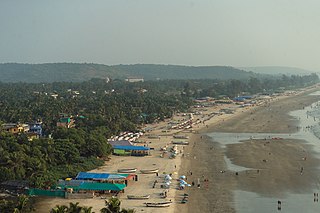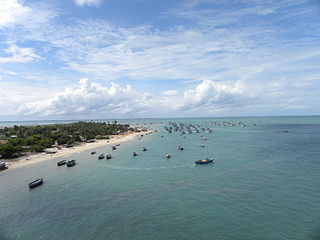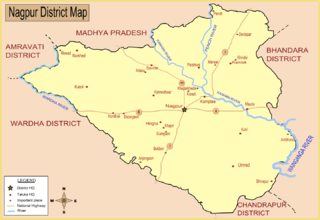
Kolhapur is a city on the banks of the Panchganga River in the southern part of the Indian state of Maharashtra.

Arambol is a traditional fisherman village in the Pernem administrative region of North Goa, India, located 24.6 km (15.3 mi) north of Goa's capital city of Panaji. As of 2011, it has a population of around 5,300.

Ramanathapuram District, also known as Ramnad District, is one of the 38 districts an administrative districts of Tamil Nadu state in southern India. The old Ramanathapuram District consists of Present day Virudhunagar and Sivagangai districts, it touches the Western ghats and bordered with the state of Kerala and east by Bay of Bengal. It was the largest district on that time. The town of Ramanathapuram is the district headquarters. Ramanthapuram District has an area of 4,123 km2. It is bounded on the north by Sivaganga District, on the northeast by Pudukkottai District, on the east by the Palk Strait, on the south by the Gulf of Mannar, on the west by Thoothukudi District, and on the northwest by Virudhunagar District. The district contains the Pamban Bridge, an east–west chain of low islands and shallow reefs that extend between India and the island nation of Sri Lanka, and separate the Palk Strait from the Gulf of Mannar. The Palk Strait is navigable only by shallow-draft vessels. As of 2011, Ramanathapuram district had a population of 1,353,445 with a sex-ratio of 983 females for every 1,000 males. The district is home to the pilgrimage centre of Rameswaram and tourist spot Dhanushkodi, an abandoned town.

Bhiwapur is a town and a tehsil in Umred subdivision of Nagpur district in Nagpur revenue Division in the Berar region in the state of Maharashtra, India. Bhiwapur city had a gram panchayat and 2015 it became a Nagar Panchayat. Mr Lav Parmanand Janbandhu (INC) became the first President of Bhiwapur Nagar Panchayat and Mr Shankar Rajeram Dadmal became first Vice President of Bhiwapur Nagar Panchayat and one of the Corporator Mr Balaji Shankar Dewalkar was winning Election by one side voting. He won the election by lot of difference.

Byadagi chilli is a variety of chilli mainly grown in the Indian state of Karnataka. It is named after the town of Byadgi which is located in the Haveri district of Karnataka. It is sometimes written as Bedgi in some supermarkets and grocery stores in India. The business involving Byadagi chillis has the second-largest turnover among all chilli varieties of India. An oil, oleoresin, extracted from these chillies is used in the preparation of nail polish and lipstick. Byadagi chilli is also known for its deep red colour; it is less spicy and is used in many food preparations of South India. Byadagi chilli has been accorded Geographical Indication (GI) in February 2011. Its GI tag is 129.

Guntur chillies are a group of chilli cultivars from the Guntur and Prakasam districts of Andhra Pradesh, India. They are renowned globally and exported to Asia, Canada, and Europe. The Guntur district is the main producer and exporter of most varieties of chillies and chilli powder from India to regions such as Sri Lanka, Bangladesh, Middle East, South Korea, the UK, the US, and Latin America. Chillies have various colours and flavours because of the level of capsaicin in them. Guntur chillies form an important part of curries and various popular dishes of the state of Andhra Pradesh in India. The main trading place for the Guntur chilli is called Guntur Mirchi Yard. Market prices for the chillies are accessible on the National Agriculture Market or e-NAM.
Sirarakhong also called as Kampha is a village located west of Ukhrul in Ukhrul district, Manipur state, India. As per 2011 census, the village has a total of 202 households with 1243 persons of which 620 are male while 623 are female. Of the total population, 10.86% are in the age group of 0–6 years. The average sex ratio of the village is 1015 female per 1000 male which is higher than the state's average of 930. The literacy rate of the village is 95.22%.
The Naga Mircha is a variety of chilli mainly grown in the Indian state of Nagaland along with being the first chilli or even the first of goods of any kind from Nagaland to be awarded a GI tag.

Chamba Chukh is a type of hot chilli prepared from locally grown chillies in the Chamba Valley of the Northern Indian State of Himachal Pradesh. The recipe is a generations old traditional preparation made from sun-dried red chillies or fresh green chillies. Blended with citrus extract from a local fruit, the Chamba Chukh preparation is a cooked chilli sauce and Chili pepper paste. Made by women in their kitchens in different parts of the Chamba district, the preparation has been highly regarded in the local region and in adjoining areas. Chamba Chukh is now gradually making its way into a broader market.

Dalle Khursani, Akabare Khursani, red cherry pepper chilli or simply Dalle is a variety of chilli pepper primarily cultivated in Bhutan, Nepal, Indian state of Sikkim, and Darjeeling and Kalimpong districts of Indian state of West Bengal. Its pungency ranges between 100,000 and 350,000 SHU, similar to the Habanero chilli pepper.
The Khola chilli is a variety of chilli mainly grown in the Indian state of Goa.
The Harmal chilli is a variety of chilli mainly grown in the Indian state of Goa.
Khola is a village located in Canacona, Goa, India. "Cola" is the variation of the same name.
The Ramanathapuram Mundu chilli is a variety of dry red chilli mainly grown in Ramanathapuram district, of the Indian state of Tamil Nadu. It is primarily grown in the Ramanathapuram district's Tiruvadanai, Mudukulathur, Kadaladi, RS Mangalam and Kamuthi taluks.
The Edayur chilli is a variety of chilli mainly grown in the Indian state of Kerala. The Edayur chilli is a local cultivar primarily grown in specific regions of Malappuram district, Kerala, India. Specifically, it is cultivated in the panchayaths of Edayur, Athavanad, Marakkara, Irimbiliyam, Kalpakanchery, and Valanchery within the Valanchery block, as well as Moorkanad and Kuruva panchayaths within the Angadippuram block.
The Mizo chilli is a variety of chilli mainly grown in the Indian state of Mizoram. It is a common and widely cultivated crop in Mizoram, and also found in parts of Manipur.
The Sirarakhong Hathei chilli is a variety of chilli mainly grown in the Indian state of Manipur. It is widely cultivated crop in Sirarakhong village in the Ukhrul district of Manipur.
The Banaras Lal Bharwamirch (Red Pickle Chilli) is a variety of chilli grown in the Indian state of Uttar Pradesh. It is mainly cultivated in Varanasi, Azamgarh, Jaunpur, Ghazipur & Ballia districts of Uttar Pradesh.
The Nandurbar Mirchi is a variety of chilli grown in the Indian state of Maharashtra. It is mainly cultivated in Nandurbar & Dhule districts of Maharashtra.
The Almora Lakhori Mirchi is a variety of chilli grown in the Indian state of Uttarakhand. It is Uttarakhand's favourite home-grown chilli.














